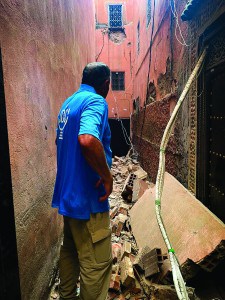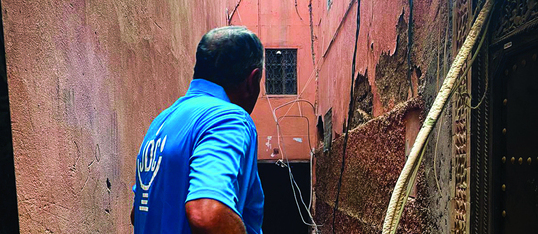 Philissa Cramer, Eliyahu Freedman
Philissa Cramer, Eliyahu Freedman
(JTA) — Jews and Jewish sites appear to have largely been spared following the devastating earthquake that struck Morocco late Friday, Sept. 8, killing more than 2,600 people, injuring thousands more, and plunging some of the poorest areas of the Northwest African country into into ruins.
The export of etrogs, the citrus fruit harvested locally and used ritually in the upcoming festival of Sukkot, also appears to be continuing largely unabated.
Israeli rescue teams are on the ground and the country has offered additional aid to Morocco as a massive humanitarian effort takes shape, the region’s largest in more than a century. The American Jewish Joint Distribution Committee, which has operated in Morocco since 1947, has staff aiding the operation there.
Dov Maisel, vice president of operations at Israel Hatzalah, an emergency aid nonprofit, said a preliminary team of four people with experience in disaster management had traveled to Morocco early Sunday, Sept. 10.
“They are describing terrible sites of destruction,” he told the Jewish Telegraphic Agency, adding that his group would determine the size and scope of its ultimate mission based on what the team observes. “Will it be more medical? Search and rescue? Psycho-trauma? This is the evaluation they are doing right now.”
JDC relief activities are coordinated with the U.S. Department of State, USAID, Israeli relief efforts, and the United Nations, as well as local and international partners.
The Jewish Agency is also in contact with the local Jewish community to assess their needs.
The 6.8-magnitude earthquake, centered in the Atlas Mountains near Marrakesh, struck at a time of heightened Jewish tourism, following Israel’s normalization of relations with Morocco in 2020. Israel said it was aware of 479 Israelis in the country at the time of the quake and had accounted for the safety of all of them.
The quake came on the eve of a major pilgrimage timed to the anniversary of a Moroccan rabbi’s death and as the country’s etrog farms were completing their harvests of etrogs leading up to the fall harvest festival of Sukkot, which begins this year on Sept. 29. Hundreds of thousands of etrogs are grown in Morocco annually ahead of the holiday.
Tradition holds that etrog trees were first planted in the Atlas Mountains nearly 2,000 years ago by Jews who found shelter amongst the Berber tribes there after the destruction of the Second Temple in Jerusalem. Today, the etrog farms in the Atlas Mountains are largely staffed by Berbers and owned by Jews living in Israel or in Agadir, a coastal city that was flattened in 1960 by an earthquake that, according to JTA’s reports at the time, killed a third of the local population overall and two-thirds of its Jewish community, about 1,500 people.
Like many people involved in the etrog trade, Tsvi Dahan was spending Shabbat in Agadir, where there is a tiny remaining Jewish community that grows during the etrog harvest. An Israeli who owns a grove about an hour away, Dahan was sleeping in a local hotel when the earth started shaking.
“I knew immediately that it was an earthquake,” Dahan said. (His wife, Deborah Danan, is a JTA correspondent in Israel.) “I put my head on the pillow and felt the bed move. I saw that the room was continuing to shake. In seven seconds, I was downstairs without anything, just my shirt and underwear.”
The hotel did not let guests reenter, so Dahan and others spent the rest of the night sleeping outside the synagogue, where etrog season means prayer quorums can be assured. The building, like the rest in the city, was built after 1960 as Agadir was reconstructed closer to the shore, downhill from the ruined city.
Dahan said he had quickly connected with Bilaid el Bouhali, the Berber who manages his grove, and learned that while el Bouhali was safe, his city of Oulad Berhil, in the mountains between Marrakesh and Agadir, was in ruins. A video taken by el Bouhali shows widespread devastation in his town, which had grown quickly in recent years.
“It’s not so nice to say but when I saw the lampposts all leaning, one of my first thoughts was, what about my [etrog] trees? I hope they’re still standing,” Dahan recalled. “Bilaid came to pick me up from Agadir and we went straight to the mountain to check on them. Thank God they’re fine.”
On Sunday, Sept. 10, Dahan was trying to figure out how to get himself and the etrogs out of the country. The Marrakesh airport was closed until further notice, but Dahan said he thought the first etrog shipments would depart on schedule.
In Marrakesh, where about 120 Jews live, many buildings have collapsed, and authorities have instructed residents to sleep outdoors for the next several days in case of aftershocks. (The majority of Morocco’s 1,500 Jews live in Casablanca, which was not affected by the earthquake.) But while many homes lay in ruins — including Dahan’s family home, where his grandmother and uncles lived until recently — relatively few deaths occurred there.
“Everything is okay — not a single Jew was injured,” said Menachem Danino, a Casablanca-born Israeli who runs a Facebook group for Moroccans in Israel. “All of the houses in the quarter were destroyed except the synagogue, which is fine with the exception of some cracks in the walls.”
Just a few miles outside the city, entire villages have crumbled, and an accounting of the injured and dead is still underway. Maisel said the Hatzalah team is part of that effort.
“They have been throughout the day on the ground meeting with officials and going out on the ground to villages between 15 to 20 kilometers outside of Marrakesh where the earthquake really wiped the villages off the face of this earth,” Maisel said.
He said his group had been alerted to the earthquake first by volunteers who happened to be in Morocco as tourists, including some who were preparing for a pilgrimage, called a hiloula, to the grave of Rabbi Haim Pinto. That pilgrimage to the coastal city of Essouira, which was set for Tuesday, Sept. 12, drew about 2,000 people last year.
Israeli Prime Minister Benjamin Netanyahu opened his Sunday Cabinet meeting by pledging support to Morocco and his counterpart there.
Another Israeli nonprofit, SmartAID, said it had sent 20 people late Saturday night, along with technology that could facilitate communication and medical care in areas without electricity and running water. And JDC is building up a team around its Casablanca-based Morocco director for a sustained aid operation.
“As we mourn the harrowing loss of life and devastation in Morocco, we’re working quickly with the Moroccan Jewish community to provide assistance to those most impacted in Marrakesh and ensure their most basic needs are being met,” Pablo Weinsteiner, JDC’s chief operating officer, said. “As we in the Jewish community approach the High Holidays, weighing the uncertain balance between life and death, and the importance of aiding those most in need, we are on the ground in Morocco to preserve life, to comfort and support the most vulnerable, and to fulfill our commitment to repairing a broken world.”
Danino said he saw divine intervention in the fact that Morocco’s many Jewish sites had apparently survived the quake.
“Graves of Jewish sages [in the affected area] were not damaged,” he said, noting that he had spoken to the people responsible for the upkeep of the tomb of Rabbi Shlomo Bel Hench, a chief rabbi of Marrakesh who died 500 years ago and is buried outside the city in Ourika.
“There have been funerals day and night at the cemetery but the tomb of Rabbi Shlomo was not damaged at all,” Danino said. “How do you explain this?”
To support JDC’s efforts in Morocco, visit: http://JDC.org/MoroccoEarthquake2023.
– – – – – – – – – – – – – – – – – – – – – – – – – – – – – – – – – –
This is part of a series spotlighting local and overseas partner agencies that are beneficiaries of the United Jewish Federation of Tidewater’s annual Community Campaign. The American Jewish Joint Distribution Committee and the Jewish Agency receive funds from UJFT.

